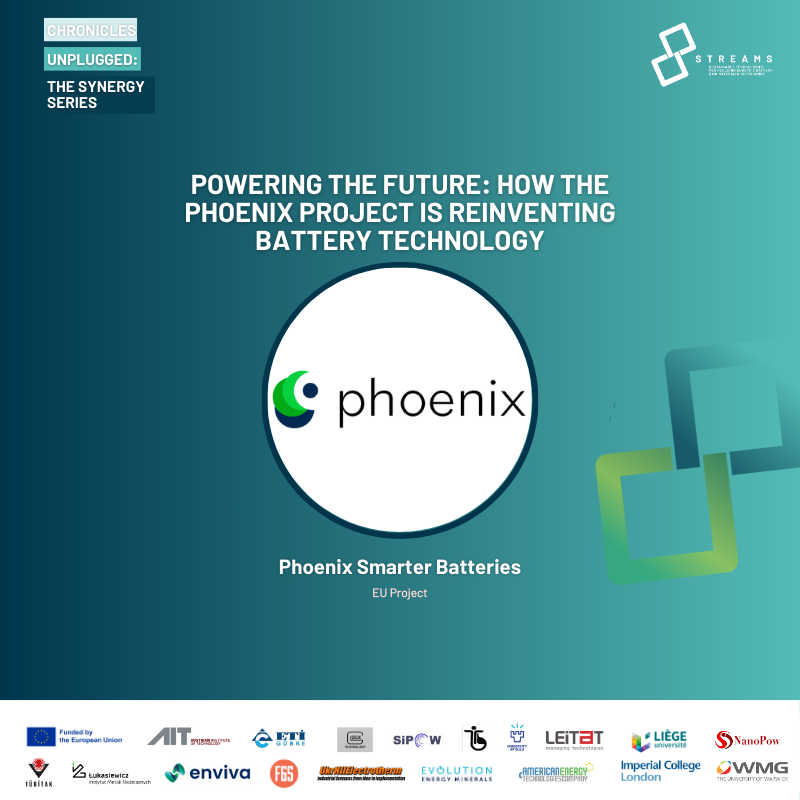In a world increasingly powered by electricity, batteries are at the core of our technological progress, from electric vehicles to renewable energy systems. Yet, as demand soars, so do the challenges: extending battery life, improving safety, enhancing sustainability, and reducing costs.
Launched in May 2023, PHOENIX is an EU and SERI funded research and innovation project committed to addressing these challenges. Part also of the broader BATTERY2030+ initiative — the European flagship for long-term battery research — PHOENIX is reimagining how batteries are designed, managed, and recycled, with a clear focus on smart functionalities and environmental responsibility.
Rethinking the battery from the inside out
PHOENIX is not just improving existing battery technologies: it’s redefining them. The project is exploring the integration of sensing technologies, triggering mechanisms, and the corresponding self-healing responses directly within battery cells, all supported by an advanced battery management system (BMS). This system enables real-time monitoring of internal conditions and early detection of performance degradation.
Thanks to these smart features, the project aims to extend battery cycle life, while ensuring high performance and lowering lifecycle costs. At the same time, PHOENIX aims at ensuring that these innovations are scalable, recyclable, and compatible with mass production.
Smarter monitoring, longer life
Keeping batteries healthy requires smart monitoring. PHOENIX has developed a new generation of sensors and triggers, including:
- Thermal, magnetic and mechanical triggers for activating self-healing mechanisms;
- Temperature sensors based on optical fibers and printed NTC materials for precise temperature monitoring
- Soft dielectric sensors with low form factor for monitoring cell expansion and pressure evolution
- Ultrasonic sensors for detecting internal mechanical changes (Young-modulus);
- Memristor gas sensors to identify harmful emissions like hydrogen;
- Reference electrodes for deeper electrochemical insights.
These components will soon be validated in multi-layer pouch cells, preparing them for real-world deployment.
The brain behind the battery: Battery Management System (BMS) development
One of PHOENIX’s first major achievements has been the successful development and commissioning of its battery management system. From early coordination with partners to define system requirements, to real-time data integration and sensor compatibility, the BMS now serves as the “digital brain” of the smart battery, a central control unit capable of making batteries safer, smarter, and longer-lasting.
A second iteration of the BMS, even more compact and efficient, is already in the works.
A collaborative, multidisciplinary effort
Behind these innovations is a diverse, highly skilled team of chemists, material scientists, electrical and mechanical engineers, software developers, and sustainability experts. The PHOENIX project thrives on collaboration, uniting expertise from across Europe to tackle the complex challenge of next-generation battery design.
A key innovation of our team is the development of self-healing polymer (SHP) binders for silicon-based anodes. While silicon offers exceptional capacity, it suffers from severe volume changes during charging cycles. To counter this, PHOENIX has developed a magnetically triggered SHP that reduces silicon degradation and extends battery life.
Another milestone is the in-situ self-healing polymer electrolyte, a solution that polymerises inside the battery once heated. This dynamic material stabilises the internal structure during operation, significantly improving long-term performance.
To prevent damage from gas build-up, the project is also introducing MOF-integrated separators capable of capturing harmful gases like hydrogen and carbon monoxide. This not only improves safety but also preserves battery performance over time.
Designing for a circular battery economy
The PHOENIX vision extends beyond performance: sustainability is built into every phase of battery development, from material sourcing to end-of-life.
Using a life cycle assessment (LCA) approach, the project is comparing the environmental impact of its self-healing batteries against conventional lithium-ion technologies. Preliminary results show that up to 80% of polymeric materials can be degraded in energy-neutral pre-treatments, allowing for more efficient recovery of critical raw materials.
Recycling strategies are being designed to fit within existing European infrastructure, ensuring both economic and environmental feasibility.
What’s next?
With its foundational technologies now developed, PHOENIX is entering a new phase focused on:
- Scaling up manufacturing;
- Validating self-healing performance in real-world conditions;
- Rolling out the next generation of BMS and sensor integration;
- Providing insight to help shaping future European battery standards and policies under the BATTERY2030+ framework.
- Collaboration with sister projects SALAMANDER and HEALINGBAT on core self-healing technologies.
As the world accelerates toward electrification, PHOENIX represents a major leap forward. By merging advanced materials science, cutting-edge electronics, and sustainability thinking, the project is creating a new blueprint for batteries that are longer-lasting, safer, smarter, and greener.
You can download the full article here.

